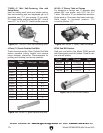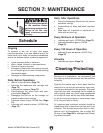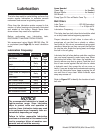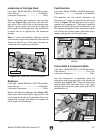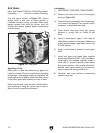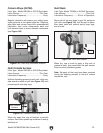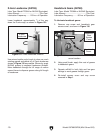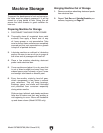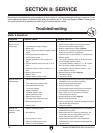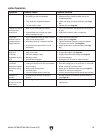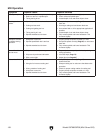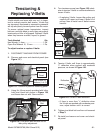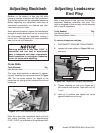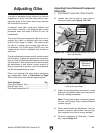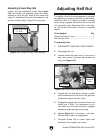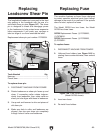
-78-
Model G0768/G0769 (Mfd. Since 8/15)
Review the troubleshooting and procedures in this section if a problem develops with your machine. If you
need replacement parts or additional help with a procedure, call our Technical Support.
Note: Please gather
the serial number and manufacture date of your machine before calling.
SECTION 8: SERVICE
Troubleshooting
Symptom Possible Cause Possible Solution
Machine does not
start or a circuit
breaker trips.
1. Emergency stop button engaged or at fault.
2. Incorrect power supply voltage.
3. Blown fuse.
4. Power supply circuit breaker tripped or fuse
blown.
5. Wiring open/has high resistance.
6. On/Off switch at fault.
7. Spindle speed dial in OFF position or at
fault.
8. Spindle direction switch turned to "0" or at
fault.
9. Lathe/mill selector switch in neutral, or at
fault.
10. Motor brushes at fault.
11. Motor at fault.
12. Spindle rotation switch at fault.
1. Press side tab in and lift switch cover. Press On
button to reset; replace if not working properly.
2. Ensure correct power supply voltage.
3. Replace fuse/ensure no shorts (Page 85).
4. Ensure circuit is sized correctly and free of shorts.
Reset circuit breaker or replace fuse.
5. Check/fix broken, disconnected, or corroded wires.
6. Replace switch.
7. Turn spindle speed dial past "0". Ensure dial has
correct voltage. Replace if faulty.
8. Turn spindle direction switch to "F" or "R". Ensure
dial has correct voltage. Replace if faulty.
9. Turn lathe/mill selector switch to "lathe" or "mill"
mode. Replace if faulty.
10. Remove/replace brushes (Page 86).
11. Test/repair/replace.
12. Test/replace switch.
Machine stalls or is
underpowered.
1. Machine undersized for task.
2. Feed rate/cutting speed too fast.
3. Wrong workpiece material.
4. Timing belt slipping.
5. Motor overheated.
6. Computer board at fault.
7. Motor speed dial at fault.
8. Motor brushes at fault.
9. Pulley/sprocket slipping on shaft.
10. Motor bearings at fault.
11. Motor at fault.
1. Use sharp bits/chisels at correct angle; reduce feed
rate/depth of cut; use coolant if possible.
2. Decrease feed rate/cutting speed.
3. Use correct type/size of metal.
4. Tension/replace belt; ensure pulleys are aligned.
5. Use sharp bits; reduce feed rate/depth of cut.
6. Clean motor, let cool, and reduce workload.
7. Test and replace if at fault.
8. Remove/replace brushes (Page 86).
9. Replace loose pulley/shaft.
10. Test by rotating shaft; rotational grinding/loose shaft
requires bearing replacement.
11. Test/repair/replace.
Machine has
vibration or noisy
operation.
1. Motor or component loose.
2. Bit chattering.
3. V-belt(s) worn or loose.
4. Motor fan rubbing on fan cover.
5. Motor mount loose/broken.
1. Inspect/replace damaged bolts/nuts, and retighten
with thread locking fluid.
2. Replace/sharpen bit; index bit to workpiece; use
correct feed rate and cutting RPM; retract tool
holder and position workpiece closer.
3. Inspect/replace belts with a new matched set.
4. Fix/replace fan cover; replace loose/damaged fan.
5. Tighten/replace.
Motor & Electrical



